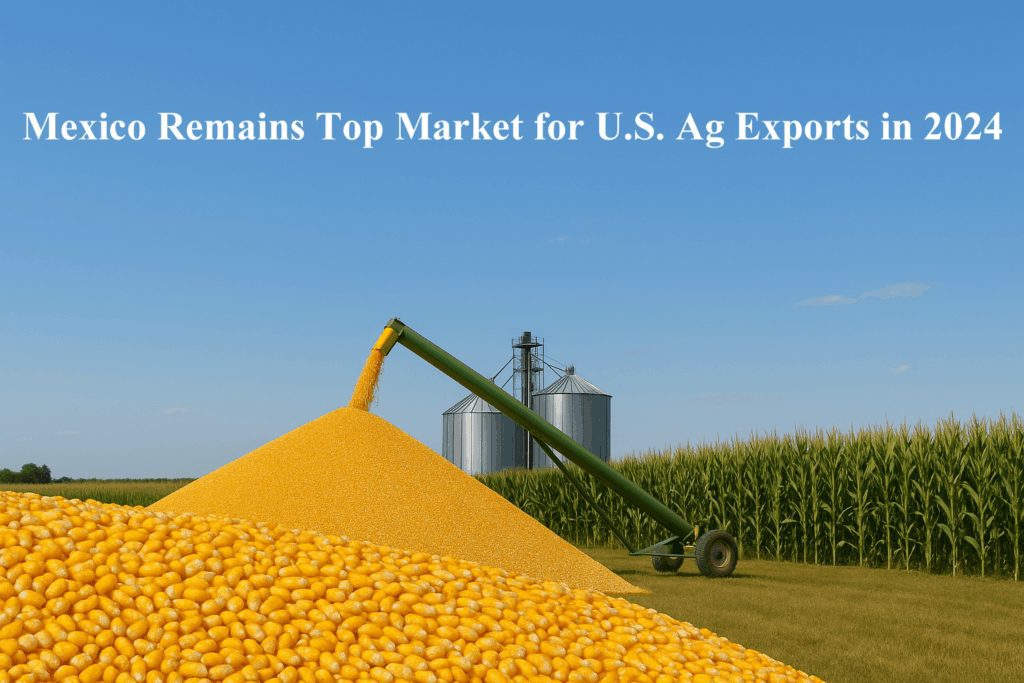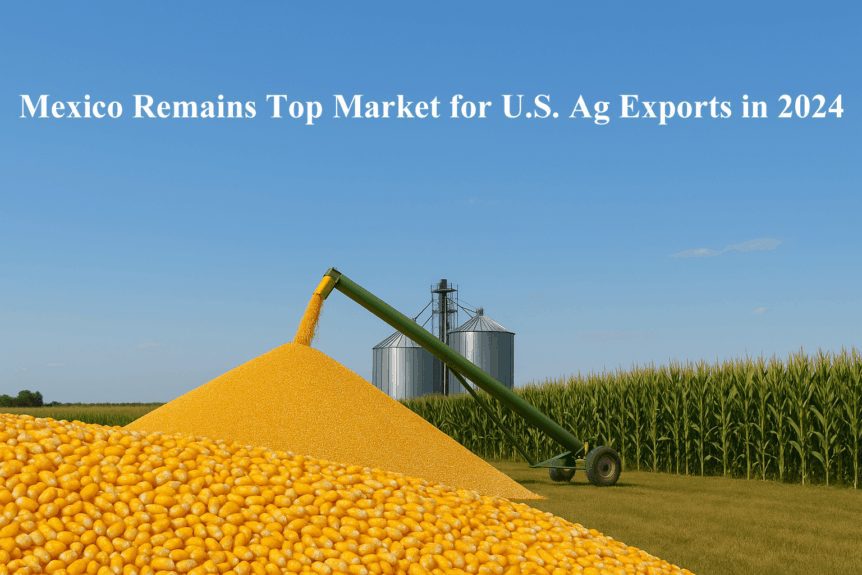U.S. Agricultural Exports to Mexico Hit $30.2 Billion in 2024

According to the latest USDA report, Mexico was the number one destination for U.S. agricultural exports in 2024, receiving $30.2 billion worth of goods. Nearly half of that came from consumer-oriented products such as meat, dairy, processed foods, and beverages.
Bulk commodities accounted for one-third of total shipments, led by corn, soybeans, wheat, and rice. Intermediate products, like soybean meal and planting seeds, made up the rest. Top individual exports included:
- Corn: $5.5 billion
- Pork Products: $2.6 billion
- Dairy: $2.5 billion
- Beef: $1.3 billion
- Fresh Fruit: $979 million
Exports of rice, sugar-based products, and food preparations all saw growth over 30%, with rice exports alone more than doubling (+102%) from 2022.
Table 1: Top U.S. Agricultural Exports to Mexico (2022-2024)
| Value Million U.S. Dollars | % Change 2022-24 | |||
| 2022 | 2023 | 2024 | ||
| 1. Corn | 4,923 | 5,324 | 5,512 | 12% |
| 2. Pork & Pork Products | 2,042 | 2,354 | 2,584 | 27% |
| 3. Dairy Products | 2,442 | 2,318 | 2,469 | 1% |
| 4. Soybeans | 3,642 | 2,791 | 2,302 | -37% |
| 5. Poultry Meat & Prods. | 1,255 | 1,265 | 1,468 | 17% |
| 6. Beef & Beef Products | 968 | 1,192 | 1,346 | 39% |
| 7. Sugar, Sweeteners, Bev. Bases | 683 | 921 | 1,243 | 82% |
| 8. Food Preparations | 854 | 909 | 1,169 | 37% |
| 9. Wheat | 1,585 | 1,081 | 1,048 | -34% |
| 10. Fresh Fruit | 735 | 823 | 979 | 33% |
| 11. Soybean Meal | 863 | 824 | 897 | 4% |
| 12. Processed Vegetables | 518 | 597 | 641 | 24% |
| 13. Distillers Grains | 726 | 676 | 636 | -12% |
| 14. Bakery Goods, Cereals, & Pasta | 416 | 489 | 608 | 46% |
| 15. Rice | 219 | 281 | 442 | 102% |
| Other Agricultural Exports | 6,595 | 6,471 | 6,847 | 4% |
| Total Agricultural Exports | 28,466 | 28,316 | 30,191 | 6% |
Source: U.S. Census Bureau Trade Data via FAS/GATS – inclusive of annual statistical correction released June 2025.
Young Demographics and Urbanization Drive Demand
Mexico’s expanding population—over 132 million strong—is dominated by younger generations like Gen Z and Millennials, with a growing preference for health-conscious and environmentally friendly food choices. Nearly 82% of the population lives in urban areas, boosting demand for imported products via retail supermarkets and restaurants.
While traditional markets still account for the majority of food sales, Mexico’s $78 billion retail food market is increasingly influenced by modern trends. Health foods, low-sugar options, and added-fiber products are rising in popularity.
Growth Outlook for Retail and Food Processing
Retail food sales in Mexico are projected to grow by 5.9% annually through 2029, according to Euromonitor. Meanwhile, the country’s food and feed processing industry continue to expand, with U.S. producers maintaining a competitive edge in supplying ingredients and feedstock.
Mexico’s agricultural sector grew by 6.7% in the first quarter of 2025, driven by strong demand for feed. As Mexico continues to import grains and oilseeds to meet consumption needs, U.S. exporters are well-positioned to benefit.
Conclusion: Expanding Opportunity for U.S. Producers
With economic growth, youthful demographics, and close trade ties, Mexico remains a strategic and growing market for U.S. farmers, ranchers, and food processors. Both seasoned exporters and small-to-mid-sized businesses can find opportunities to increase sales in this key market.
For more information on how to export to Mexico, contact the U.S. Agricultural Trade Office in Mexico City or Monterrey.










